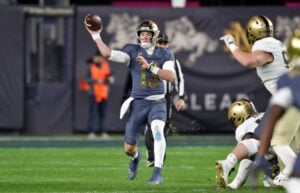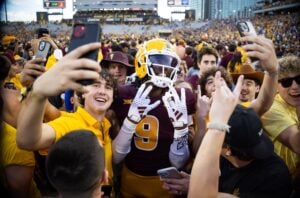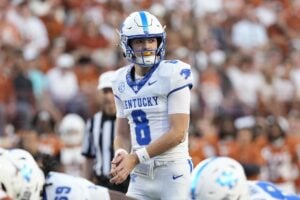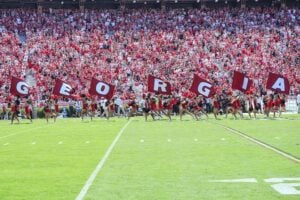As the UCLA football program tumbles to another less-than-expected season, deep divisions are growing within the “Bruins nation.” UCLA was picked by the media to win the Pac 12 South in 2016, and while that is still mathematically possible, it is amazingly unlikely just three games into the conference schedule. Where did they go wrong and why do they routinely go to the same wrong?
How Did They Get Here?
To understand the mindset of the UCLA faithful, you have to know that the Bruins have had only one shot at college football elite status in the last two decades; 18 years, four coaches, and numerous unfilled expectations ago. To many, the program has not been the same since a fateful Saturday afternoon in Miami on the first weekend of December in 1998. UCLA was riding a 20-game winning streak over two seasons. Its defense was giving up points at video game levels, but quarterback Cade McNown and gun slinging coach Bob Toledo matched every offensive challenge all season, averaging 40 points and more than 450 yards of offense per game. The Bruins were in Miami to play the Hurricanes in a game that was scheduled for opening weekend of that season, but was delayed by Hurricane Georges. It was a championship Saturday before the TV networks created such a national phenomenon. In the first season of the BCS era, UCLA was #2 in the country. Meanwhile, the nation’s two other undefeated teams, Tennessee and Kansas State, were playing for conference titles while UCLA prepared to face a Miami team that had lost by 53 points to Syracuse the week before. The Bruins went on to give up a 17-point lead and lose in the closing minutes of the game, thus ending the shot at the championship. UCLA has not been remotely close since.
There were many who were aware of a team deeply divided going into that game, and the stories of how Toledo made it worse. There were also on-field problems, (defensive coordinator Nick Allioti not realizing he only had 10 players on the field in a critical goal line stand). Regardless of blame, it set a tone that has lasted for nearly two decades. UCLA became known as a team that cannot close the deal when the lights shine the brightest on the biggest stages. Perhaps the real issue though is that the program has spent 18 years trying to self-correct and has not gotten any closer to fulfillment.
The Coaching Carousel
Toledo was fired in 2002. Once he did not win as much, the rumors of NCAA rule-bending by the staff became louder, and he was not going to be protected. Athletic Director Dan Guerrero hired former UCLA wide receiver Karl Dorrell who, at the time was the receivers coach for the Denver Broncos, but had never been a head coach anywhere. He had an ignominious start to his career when, following his first game, he was asked what took the most getting used to as a head coach, and his response was that he had to remember where to stand on the sidelines.
Dorrell, was soft-spoken, efficient, squeaky clean, (read anti-Toledo), and in over his head right away. They lost the Silcon Valley, Las Vegas and Emerald Bowls over his first four seasons. In 2007, his fifth season, the Bruins had 20 returning starters and a #11 national ranking, and then they did what UCLA has done consistently since 1998. They lost to a winless Utah team, a winless Notre Dame team, and a terrible Washington State team. Dorrell was fired.
In came the audacious and gregarious former UCLA quarterback Rick Neuheisel. He had seen some success at Colorado and Washington, but NCAA sanctions cost him his job in Seattle. He spent a year as a volunteer high school coach in Washington and two years on the Baltimore Ravens staff trying to resurrect his reputation. Neuheisel had the credentials, and he had the UCLA pedigree. After all, he was MVP of the 1984 Rose Bowl win over Illinois where he threw four touchdown passes, with two of them going to, ironically enough, wide receiver Karl Dorrell.
Neuheisel though, like Dorrell before him, had more than just a coaching challenge. He was now working crosstown from the Pete Carroll juggernaut at USC. Still, he came up with phrases like having your “passion bucket” filled to be at UCLA, and he took part in a full page ad that ran in every local sports section declaring “The Football Monopoly in L.A. Is Officially Over.” His brashness landed him some top 10 recruiting classes, but his teams never lived up to the promise. A 21-29 record over four years with one bowl appearance, (the now defunct Eagle Bank Bowl), was bad enough, but the 2011 season ending 50-0 loss to USC, the Bruins’ fifth straight loss to the Trojans, was too much to handle. Neuheisel was fired before the team’s loss in the Kraft Fight Hunger Bowl in 2011. UCLA was now looking for its third head coach in 10 years.
That brings us to the current coach, Jim Mora, and what he has coined, the “Bruin Revolution.” In January of 2012, Mora was hired with no college head coaching experience, but Guerrero picked him because of his NFL background, (head coaching stints in Atlanta and Seattle). It was assumed that would be a draw for recruits, much as Carroll’s NFL career had helped his recruiting across town. Just as importantly, Carroll was now in the NFL, USC was struggling with coaching issues, and the door was wide open for Mora to take over the town as Neuheisel had promised he would.
The Jim Mora Era Begins
Mora delivered quickly, or so it seemed. Three straight wins over USC, 29-11 in his first three seasons and three second tier bowl game appearances. The campus and the Rose Bowl stadium were quickly plastered with his revolution posters. But even with a new face at the helm, the program suffered the same lapses when it came to closing the deal. His 2012 team lost to Stanford to close the regular season, and then again the following week in the conference championship game before being pummeled by Baylor in the Holiday Bowl. In 2013, the Bruins were 5-0 before being outscored 66-24 over two games against Stanford and Oregon on national television. In 2014, it was a 4-0 start before back-to-back losses to Utah and Oregon on national television followed by a season ending, 21-point loss to Stanford. The year 2015 was perhaps the most painful for Mora and his supporters. UCLA was playing with a true freshman quarterback, but Josh Rosen was the #1 high school quarterback in the country the previous year. He graduated high school a semester early in order to enroll in UCLA for the spring and start working with the team. Surrounded by a bounty of four- and five-star recruits, Rosen was the key to a future that was to be bright for UCLA. The future dimmed a little with back to back losses, in highlighted national games of course, to Arizona State and Stanford. The lights got dimmer still, losing three of the last four games, including the USC game and a third tier bowl games against Nebraska.
In Part 2 of the story we will take a look at the current incarnation of UCLA football and how the fan base is taking to more unfulfilled potential under Jim Mora.
Main Photo:






